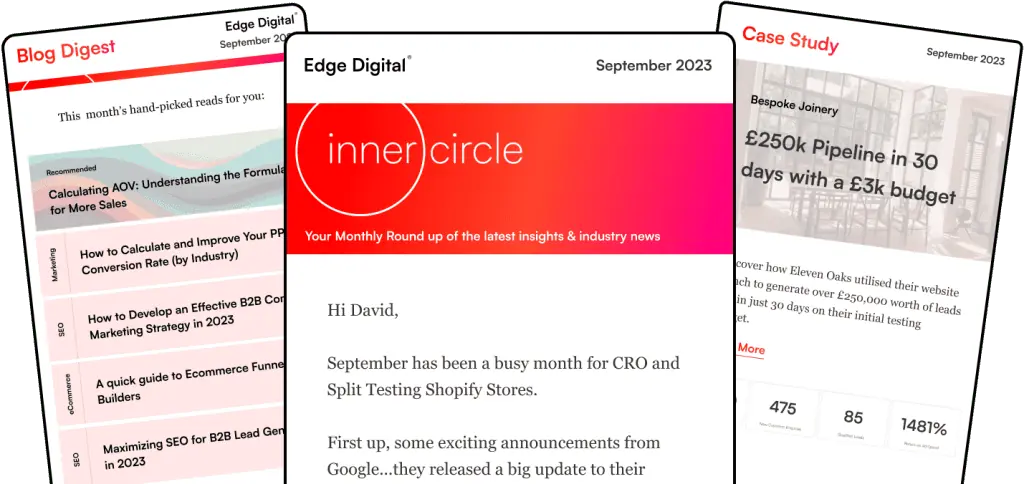A/B split testing has become an indispensable tool for marketers, web designers, and businesses alike. This powerful method allows you to make data-driven decisions and optimize user experiences, helping you stay ahead of the competition. But what exactly is A/B split testing, and how can you harness its power to improve your marketing campaigns, website design, and overall user experience? In this comprehensive guide, we will dive deep into the world of A/B split testing, exploring its principles, ab split testing best practices, and potential pitfalls to avoid. Get ready to unlock a new level of understanding and supercharge your online presence through effective conversion rate optimization to improve business metrics and user experience.
Key Takeaways
A/B split testing is used to compare versions of a variable and measure user engagement, conversions, and revenue.
Best practices for designing A/B tests include focusing on one variable at a time, ensuring an adequate sample size, using control groups and considering other factors like timing.
Iterative A/B testing enables continuous improvement by refining hypotheses & test designs based on insights gained from past tests.

split testing will help you identify which is the highest performer
Understanding A/B Split Testing
A/B split testing, sometimes referred to as A/B testing or simply split testing, is a method used to compare two versions of a variable to determine which performs better. It enables businesses to make informed decisions and optimize user experiences by measuring how much traffic each version attracts and which one delivers superior results. A/B testing is often employed in the optimization of web pages, marketing campaigns, and even product offerings, with a focus on maximizing conversions, user engagement, and revenue.
To improve your digital marketing strategy and user experience, it is crucial to run split tests. Running these tests provides qualitative feedback and ensures that changes are statistically significant before implementation.
There are two primary types of A/B tests that can be used for optimizing website conversion rates: multivariate testing and split testing. A multivariate test involves evaluating multiple variables simultaneously on the same web page, while split testing compares two versions of a variable to determine which is more effective.
You must adhere to a few best practices in designing A/B tests to guarantee accurate and reliable results. These practices include focusing on a single variable at a time, securing a sizeable sample size, and utilizing control groups. These steps facilitate the collection of essential data and support the formulation of decisions grounded in that data.
What is A/B Split Testing?
A/B split testing is a process of randomized experimentation in which two or more versions of a variable are shown to different segments of website visitors at the same time. This allows you to measure the impact of each version on user behavior and preferences, helping you determine the most effective design or content.
There are several primary methods of A/B split testing, including:
A/B testing
Split URL testing
Multivariate testing
Multipage testing
To set up and analyze these tests, you can use split testing tools like Google Optimize, Optimizely, and VWO.
Each method has its own benefits which make it ideal for particular situations. By utilizing these methods, businesses can optimize their website traffic and improve user experience.
Grasping the concept of statistical significance is vital in A/B testing. This understanding aids in discerning if the observed differences between the two versions are likely a coincidence or a genuine effect. The larger the sample size and the more data collected, the greater the statistical power of the test, leading to more reliable and accurate results. By using tools such as Google Analytics, Success Path or Visual Website Optimizer, you can calculate the statistical significance of your A/B tests and ensure that any conclusions drawn from the test results are truly meaningful.
Why is A/B Split Testing Important?
A/B split testing is a key tool for enhancing marketing campaigns, website design, and user experience, thereby leading to a surge in conversions and revenue. By conducting A/B tests, businesses can gain insights into user behavior and preferences, enabling them to make data-driven decisions and refine their strategies accordingly.
Maintaining an open mindset during A/B testing is critical, given the uniqueness of each test and the possibility that successful approaches from a previous test may not produce similar results in a different one. By analyzing the results of past tests and learning from your successes and failures, you can continuously refine your hypotheses, test designs, and overall testing process, ensuring more effective tests in the future. Insights gained from these tests can also inform future tests and strategies, leading to continuous improvement.
Moreover, by staying receptive to new ideas and insights derived from factual data and established user behavior, you can better adapt to the ever-changing preferences of your target audience and understand customer behavior.
Developing a Solid Hypothesis
The foundation of any successful A/B test is a solid hypothesis, which serves to guide the testing process and ensure that the results are meaningful and relevant. A well-formed hypothesis clearly outlines the expected outcome of the test and the variable being tested, allowing you to focus your efforts on the most impactful changes and optimize your performance. Formulating a robust hypothesis increases the likelihood of your A/B tests producing statistically significant results and offering valuable insights into user behavior and preferences.
Optimizing landing pages through A/B split testing is crucial to improve conversion rates. By testing different designs and layouts, you can identify the best-performing versions and enhance user experience.
To develop a solid hypothesis, you must first identify the key metrics that you will use to measure the success of your A/B test. These metrics, such as conversion rates, click-through rates, or time on page, will serve as the basis for your hypothesis and help you determine the most effective changes to implement. Once you have identified your key metrics, you can then formulate a testable hypothesis based on your data and insights, ensuring that your A/B tests are focused on the most important aspects of your website or marketing campaign.
Identifying Key Metrics
Identifying key performance indicators to evaluate the performance of each variation is essential for effective measurement of your A/B tests’ success. These indicators can include:
Conversion rates
Click-through rates
Time on page
Bounce rates
Number of sign-ups
These data points can help you determine which changes have the greatest impact on user behavior and performance.
By focusing on the most important metrics, you can ensure that your A/B tests are designed to address specific objectives or outcomes, allowing you to make informed decisions about the best course of action for your website or marketing campaign. Additionally, by segmenting your audience and analyzing the results of your tests based on specific user groups, you can gain even more valuable insights into the preferences and behaviors of your target audience. This information can be invaluable in driving future tests and optimizations, ensuring that your efforts are always focused on the most impactful variables.
Formulating a Testable Hypothesis
Creating a testable hypothesis is a pivotal step in the A/B testing process. It guarantees that your tests are centered on specific objectives, and the results can be reliably measured and analyzed. A testable hypothesis should be based on data and insights, detailing the expected outcome of the test and the variable being tested. This allows you to concentrate your efforts on the most impactful changes and optimize your performance.
When developing a testable hypothesis, it is important to consider both the data and insights that you have gathered from previous tests, as well as any additional information that may be relevant to your specific goals or objectives. By doing so, you can ensure that your hypothesis is grounded in reality and that it accurately reflects the potential impact of the changes being tested. This, in turn, will help to ensure that your A/B tests are more likely to yield statistically significant results and provide valuable insights into user behavior and preferences.
Best Practices for Designing A/B Tests for Conversion Rate Optimization
Effective A/B test design necessitates adherence to best practices for achieving accurate and actionable results. These best practices include:
Focusing on one variable at a time
Ensuring an adequate sample size
Using control groups to compare the performance of the test variation against a baseline
By adhering to these guidelines, you can increase the likelihood of obtaining reliable data and making informed decisions based on the results of your tests as you collect data.
It is also important to consider other factors when designing A/B tests, such as the timing of the test, the platform on which it is being conducted, and the specific audience segments that are being targeted. By taking these factors into account, you can ensure that your A/B tests are designed to address the most relevant issues and deliver the most meaningful results.
Focus on One Variable at a Time
A vital best practice for designing effective A/B tests is concentrating on a single variable at one time. This approach allows you to isolate the impact of each change and accurately measure its effect on the desired outcome. By testing one variable at a time, you can ensure that any observed differences in performance between the two versions are directly attributable to the specific change being tested, rather than being the result of multiple, interacting variables.
Focusing on one variable at a time also helps to simplify the analysis and interpretation of the test results, making it easier to draw reliable conclusions and make informed decisions about the best course of action for your website or marketing campaign. By adhering to this best practice, you can ensure that your A/B tests are more likely to yield accurate and meaningful results, ultimately helping you optimize your performance and achieve your business goals.

Testing different variables for the same amount of time, leads to more accurate results
Ensure Adequate Sample Size
Ensuring a sufficient sample size is another crucial best practice for designing effective A/B tests. A larger sample size increases the statistical power of your test, which can help to reduce the margin of error and ensure that your results are more reliable and accurate. By having a sufficient sample size, you can also improve the likelihood of obtaining statistically significant results, allowing you to make more informed decisions about the changes being tested.
To determine the appropriate sample size for your A/B test, you can use various tools, such as online sample size calculators, which can help you calculate the number of interactions or visitors needed to obtain accurate results. By ensuring an adequate sample size, you can increase the likelihood of obtaining meaningful insights from your A/B tests and make more informed decisions about the best course of action for your website or marketing campaign.
Use Control Groups
The use of control groups is another essential best practice for designing effective A/B tests. Control groups serve as a baseline against which the performance of the test variation can be compared, helping to account for external factors and biases that may otherwise influence the results. By comparing the performance of the test variation against a control group, you can ensure that any observed differences in performance are directly attributable to the specific change being tested, rather than being the result of random chance or external influences.
To set up a control group for your A/B test, you will need to:
Establish a hypothesis
Select the appropriate splitting and evaluation metrics
Create the control and test groups
Determine the length of the A/B test
Ensure that the sample groups are split equally and randomly.
By using control groups in your A/B testing, you can increase the accuracy and reliability of your test results, ultimately helping you make more informed decisions about the changes being tested.
Analyzing and Interpreting A/B Test Results
Thoroughly analyzing and interpreting the results of your A/B tests is a vital step towards making decisions based on data and enhancing your performance. By carefully examining the data from your tests and identifying trends and patterns, you can gain valuable insights into user behavior and preferences, allowing you to make informed decisions about the best course of action for your website or marketing campaign.
Utilizing AI and machine learning can predict successful variations and automate the optimization process, making your analysis more efficient and accurate.
When analyzing the results of your A/B tests, it is important to consider the following factors:
Effect size
Practical significance
The possibility of false positives or other biases that may influence the results
By taking these factors into account, you can ensure that your A/B tests are more likely to yield accurate and meaningful results, ultimately helping you optimize your performance and achieve your business goals.
Understanding Statistical Significance
Statistical significance is a crucial concept in A/B testing. It assists in determining if the observed variances in conversion rates between the two variations are likely a result of chance or a real effect. In other words, it measures the probability that the observed difference in performance between the two versions is not simply a result of random variation. By understanding statistical significance, you can ensure that your A/B tests are more likely to yield accurate and meaningful results, allowing you to make more informed decisions about the changes being tested.
To determine the statistical significance of your A/B tests, you can use various tools and techniques, such as online calculators or specialized software like Google Analytics. By ensuring that your test results are statistically significant, you can increase the likelihood of obtaining reliable and actionable insights from your A/B tests, ultimately helping you optimize your performance and achieve your business goals.
Identifying Trends and Patterns
Identifying trends and patterns in the data from your A/B tests is another crucial aspect of analyzing and interpreting test results. By examining the data and looking for patterns or trends, you can gain valuable insights into user behavior and preferences, allowing you to make more informed decisions about the best course of action for your website or marketing campaign.
Some ways to identify trends and patterns in your A/B test data include:
Plotting the data over time to see if there are any consistent patterns or trends
Segmenting the data by different user groups or demographics to see if there are any differences in behavior
Analyzing the data using statistical techniques such as regression analysis or clustering to identify relationships or patterns
These insights can help you optimize your website design, user experience, and landing page, ultimately leading to improved performance and higher conversion rates.
Some common trends and patterns observed in A/B test results include:
Click-through rate (CTR)
Bounce rate
Scroll depth
Abandonment rate
By analyzing these metrics and looking for patterns or trends, you can identify areas for improvement and prioritize your efforts based on the potential impact of each change. This approach can help you focus on the most important aspects of your website or marketing campaign, ensuring that your A/B tests are more likely to yield accurate and meaningful results.
Making Data-Driven Decisions
The primary objective of A/B testing is to use the test results to make informed decisions about modifications to your website, marketing campaigns, or product offerings. By carefully analyzing the data from your tests and identifying trends and patterns, you can gain valuable insights into user behavior and preferences, allowing you to make data-driven decisions about the best course of action for your business.
For example, if your A/B test results show that a particular design change led to a significant increase in conversion rates, you might decide to implement that change across your entire website or marketing campaign. Conversely, if a change had little impact on performance or even led to a decrease in conversions, you might decide to abandon that change and focus on other areas of improvement.
By making data-driven decisions based on the results of your A/B tests, you can continually optimize your performance and adapt to changing user preferences and market conditions.

Data driven decisions provide better optimisation.
Common A/B Testing Pitfalls to Avoid
Although A/B testing is a highly effective tool for optimizing your website and marketing campaigns, it’s important to sidestep a few common pitfalls to guarantee accurate and reliable test results. By being aware of these potential issues and taking steps to avoid them, you can ensure that your A/B tests are more likely to yield meaningful insights and help you make informed decisions about the best course of action for your business.
Some common A/B testing pitfalls to avoid include testing too many variables simultaneously, disregarding statistical significance, and not allowing sufficient time for tests to run. By being mindful of these potential issues and following best practices for designing and conducting A/B tests, you can increase the likelihood of obtaining accurate and meaningful results from your tests, ultimately helping you optimize your performance and achieve your business goals.
Testing Too Many Variables
A common pitfall in A/B testing is attempting to test too many variables at once. When multiple variables are tested simultaneously, it can be difficult to determine which specific variable or combination of variables is responsible for any observed differences in performance. This can lead to inconclusive results and make it challenging to identify the most effective changes to implement in your website or marketing campaign.
To avoid this pitfall, it is important to focus on testing one variable at a time, allowing you to isolate the impact of each change and accurately measure its effect on the desired outcome. By following this best practice, you can ensure that your A/B tests are more likely to yield accurate and meaningful results, ultimately helping you optimize your performance and achieve your business goals.
Ignoring Statistical Significance
Another common pitfall in A/B testing is ignoring statistical significance when interpreting test results. Statistical significance is a measure of the probability that the observed differences between the two versions are not simply a result of random chance. By disregarding statistical significance, you may end up making decisions based on random fluctuations in the data rather than genuine effects, which can lead to wasted resources and missed opportunities for optimization.
To avoid this pitfall, it is important to calculate the statistical significance of your A/B tests and ensure that any conclusions drawn from the test results are truly meaningful. By doing so, you can increase the likelihood of obtaining accurate and actionable insights from your tests, ultimately helping you optimize your performance and achieve your business goals.
Not Allowing Enough Time for Tests
A final pitfall to avoid in A/B testing is not allowing enough time for tests to run. Short test durations may not yield reliable results, as they may not provide enough data to achieve statistical significance. Without sufficient data, you may be unable to draw accurate conclusions about the effectiveness of the changes being tested, leading to missed opportunities for optimization and potentially wasted resources.
To avoid this pitfall, it is important to ensure that your A/B tests run for a sufficient test duration to collect enough data and achieve statistical significance. By doing so, you can increase the likelihood of obtaining accurate and meaningful results from your tests, ultimately helping you optimize your performance and achieve your business goals.
Continuous Improvement through Iterative Testing
A key benefit of A/B testing is its capacity for constant enhancement. By iterating on your tests and refining your hypotheses, test designs, and testing process, you can continually optimize your marketing campaigns, website design, and user experience, ultimately leading to improved performance and higher conversion rates. Running split tests is crucial for continuously improving marketing efforts and user experience by comparing different versions to see which performs better.
Iterative A/B testing allows you to learn from past tests, refine your strategies based on the insights gained, and adapt to changing user preferences and market conditions. By continually testing and optimizing different elements of your website or marketing campaign, you can ensure that your efforts are always focused on the most impactful variables, ultimately helping you achieve your business goals.
Learning from Past Tests
Gleaning lessons from previous tests is a vital component of iterative A/B testing. By analyzing the results of previous tests and identifying areas for improvement, you can refine your hypotheses, test designs, and overall testing process, ensuring more effective tests in the future.
To learn from past tests, it is important to examine the results, segment the data, and record any insights or learnings that can inform future test designs. By doing so, you can ensure that your future A/B tests are more likely to yield accurate and meaningful results, ultimately helping you optimize your performance and achieve your business goals.
Refining Hypotheses and Test Designs
Another essential aspect of iterative A/B testing is refining your hypotheses and test designs based on the findings of past tests. By analyzing the outcomes of previous tests and identifying areas for improvement, you can formulate more precise and impactful hypotheses, ultimately leading to more effective tests and improved performance.
Some strategies for refining your hypotheses and test designs include:
Analyzing results from prior tests
Segmenting data
Ranking ideas for testing
Consistently refining and enhancing your testing process
By following these strategies, you can ensure that your future A/B tests are more likely to yield accurate and meaningful results, ultimately helping you optimize your performance and achieve your business goals.
Iterating on Tests for Optimal Performance
The key to continuous improvement through A/B testing lies in iterating on your tests for optimal performance. By analyzing the results of each test and making data-driven decisions based on the insights gained, you can continually refine your website design, user experience, and marketing campaigns, ultimately leading to improved performance and higher conversion rates.
To iterate on your tests for optimal performance, it is important to analyze the results, identify trends and patterns, and adapt your testing process based on the insights gained. By doing so, you can ensure that your A/B tests are more likely to yield accurate and meaningful results, ultimately helping you optimize your performance and achieve your business goals.
Summary
In conclusion, A/B split testing is a powerful tool for optimizing your website design, marketing campaigns, and user experience, ultimately leading to increased conversions and revenue. By following best practices, avoiding common pitfalls, and focusing on continuous improvement through iterative testing, you can harness the power of A/B testing to make data-driven decisions and stay ahead of the competition. Remember, the key to success lies in constantly learning from past tests, refining your hypotheses and test designs, and adapting to changing user preferences and market conditions.
Frequently Asked Questions
What are the best practices for AB testing?
When conducting A/B testing best practices dictate that you should test one element at a time, determine the sample size and goal of the test, split the sample groups equally and randomly, and ensure the test runs for the duration needed to collect reliable data. Additionally, take care to only run one test at a time in any campaign and avoid making changes mid-test.
How do you split users in AB testing?
AB testing splits users into two groups – a control group and a variant group – either when they first land on the website or when they enter the shopping cart page for the first time.
What is the rule of thumb for the ab test?
When conducting an A/B test, a reliable result should include a minimum of 30,000 visitors and 3,000 conversions per variant, to ensure enough traffic and conversions for statistically significant results.
What is the difference between AB testing and split testing?
A/B testing is used to compare two versions of a single web page, typically making small changes such as font color or font style. On the other hand, split testing evaluates more significant page level changes and splits website traffic between the existing variations.
Understanding why is split testing beneficial can help in assessing website or campaign effectiveness and making data-driven changes based on customer preferences.
What is the main difference between A/B split testing and multivariate testing?
A/B split testing focuses on one variable at a time, while multivariate testing allows you to test multiple variables at once to find the best combination.



